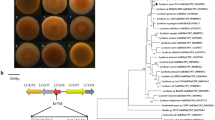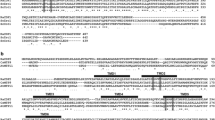Abstract
In response to environmental change, the cyanobacterium Nostoc punctiforme ATCC 29133 produces highly adapted filaments known as hormogonia that have gliding motility and serve as the agents of infection in symbioses with plants. Hormogonia sense and respond to unidentified plant-derived chemical signals that attract and guide them towards the symbiotic tissues of the host. There is increasing evidence to suggest that their interaction with host plants is regulated by chemotaxis-related signal transduction systems. The genome of N. punctiforme contains multiple sets of chemotaxis (che)-like genes. In this study we characterize the large che5 locus of N. punctiforme. Disruption of NpR0248, which encodes a putative CheR methyltransferase, results in loss of motility and significantly impairs symbiotic competency with the liverwort Blasia pusilla when compared with the parent strain. Our results suggest that chemotaxis-like elements regulate hormogonia function and hence symbiotic competency in this system.





Similar content being viewed by others
References
Adams DG, Duggan PS (2008) Cyanobacteria-bryophyte symbioses. J Exp Bot 59:1047–1058
Adams DG, Duggan PS (2011) Signalling in cyanobacteria-plant symbioses. In: Perotto S, Baluška F (eds) Signalling and communication in plant symbiosis. Springer, Dordrecht, pp 93–122
Adams DG, Duggan PS, Jackson O (2012) Symbiotic interactions. In: Whitton B (ed) The ecology of cyanobacteria II: their diversity in space and time. Springer, Dordrecht, pp 593–647
Anderson DC, Campbell EL, Meeks JC (2006) A soluble 3D LC/MS/MS proteome of the filamentous cyanobacterium Nostoc punctiforme. J Proteome Res 5:3096–3104
Bantinaki E, Kassen R, Knight CG, Robinson Z, Spiers AJ, Rainey PB (2007) Adaptive divergence in experimental populations of Pseudomonas fluorescens. III. Mutational origins of wrinkly spreader diversity. Genetics 176:441–453
Barahona E, Navazo A, Yousef-Coronado F, Aguirre de Cárcer D, Martínez-Granero F, Espinosa-Urgel M, Martín M, Rivilla R (2010) Efficient rhizosphere colonization by Pseudomonas fluorescens f113 mutants unable to form biofilms on abiotic surfaces. Environ Microbiol 12:3185–3195
Barnakov AN, Barnakova LA, Hazelbauer GL (1998) Comparison in vitro of a high- and a low-abundance chemoreceptor of Escherichia coli: similar kinase activation but different methyl-accepting activities. J Bacteriol 180:6713–6718
Barnakov AN, Barnakova LA, Hazelbauer GL (1999) Efficient adaptational demethylation of chemoreceptors requires the same enzyme-docking site as efficient methylation. Proc Natl Acad Sci U S A 96:10667–10672
Bergman B, Matveyev A, Rasmussen U (1996) Chemical signalling in cyanobacterial-plant symbioses. Trends Plant Sci 1:191–197
Bergman B, Rasmussen U, Rai AN (2007) Cyanobacterial associations. In: Elmerich C, Newton WE (eds) Associative and endophytic nitrogen-fixing bacteria and cyanobacterial associations. Kluwer Academic Publishers, Dordrecht, pp 257–301
Bergman B, Ran L, Adams DG (2008) Cyanobacterial-plant symbioses: signaling and development. In: Herrero A, Flores E (eds) The cyanobacteria: molecular biology, genomics and evolution. Caister Academic Press, Norfolk, pp 447–473
Bhaya D, Takahashi A, Grossman AR (2001) Light regulation of type IV pilus-dependent motility by chemosensor-like elements in Synechocystis PCC 6803. Proc Natl Acad Sci U S A 98:7540–7545
Blatch GL, Lassle M (1999) The tetratricopeptide repeat: a structural motif mediating protein-protein interactions. Bioessays 21:932–939
Bren A, Eisenbach M (2000) How signals are heard during bacterial chemotaxis: protein-protein interactions in sensory signal propagation. J Bacteriol 182:6865–6873
Bustamante VH, Martinez-Flores I, Vlamakis HC, Zusman DR (2004) Analysis of the Frz signal transduction system of Myxococcus xanthus shows the importance of the conserved C-terminal region of the cytoplasmic chemoreceptor FrzCD in sensing signals. Mol Microbiol 53:1501–1513
Cai Y, Wolk CP (1990) Use of a conditionally lethal gene in Anabaena sp. strain PCC 7120 to select for double recombinants and to entrap insertion sequences. J Bacteriol 172:3138–3145
Campbell EL, Meeks JC (1989) Characteristics of hormogonia formation by symbiotic Nostoc spp. in response to the presence of Anthoceros punctatus or its extracellular products. Appl Environ Microbiol 55:125–131
Campbell EL, Summers ML, Christman H, Martin ME, Meeks JC (2007) Global gene expression patterns of Nostoc punctiforme in steady-state dinitrogen-grown heterocyst-containing cultures and at single time points during the differentiation of akinetes and hormogonia. J Bacteriol 189:5247–5256
Chapman KE, Duggan PS, Billington NA, Adams DG (2008) Mutation at different sites in the Nostoc punctiforme cyaC gene, encoding the multiple-domain enzyme adenylate cyclase, results in different levels of infection of the host plant Blasia pusilla. J Bacteriol 190:1843–1847
Christman HD, Campbell EL, Meeks JC (2011) Global transcription profiles of the nitrogen stress response resulting in heterocyst or hormogonium development in Nostoc punctiforme. J Bacteriol 193:6874–6886
Chung YH, Cho MS, Moon YJ, Choi JS, Yoo YC, Park YL, Lee KM, Kang KW, Park YM (2001) ctr1, a gene involved in a signal transduction pathway of the gliding motility in the cyanobacterium Synechocystis sp. PCC 6803. FEBS Lett 492:33–38
Clausznitzer D, Oleksiuk O, Løvdok L, Sourjik V, Endres RG (2010) Chemotactic response and adaptation dynamics in Escherichia coli. PLoS Comput Biol 6:e1000784
Cohen MF, Meeks JC (1997) A hormogonium regulating locus, hrmUA, of the cyanobacterium Nostoc punctiforme strain ATCC 29133 and its response to an extract of a symbiotic plant partner Anthoceros punctatus. Mol Plant Microbe Interact 10:280–289
Cohen MF, Wallis JG, Campbell EL, Meeks JC (1994) Transposon mutagenesis of Nostoc sp. strain ATCC 29133, a filamentous cyanobacterium with multiple cellular differentiation alternatives. Microbiology 140:3233–3240
D’Andrea LD, Regan L (2003) TPR proteins: the versatile helix. Trends Biochem Sci 28:655–662
Djordjevic S, Goudreau PN, Xu Q, Stock AM, West AH (1998) Structural basis for methylesterase CheB regulation by a phosphorylation-activated domain. Proc Natl Acad Sci U S A 95:1381–1386
Duggan PS, Adams DG (2009) Molecular communication between cyanobacteria and their host plants: role of chemotaxis in symbiotic competency. 13th International Symposium on Phototrophic Prokaryotes. Montréal, QC, Canada p 099
Duggan PS, Gottardello P, Adams DG (2007) Molecular analysis of genes involved in pilus biogenesis and plant infection in Nostoc punctiforme. J Bacteriol 189:4547–4551
Enderlin CS, Meeks JC (1983) Pure culture and reconstitution of the Anthoceros-Nostoc symbiotic association. Planta 158:157–165
Hess JF, Bourret RB, Simon MI (1988) Histidine phosphorylation and phosphoryl group transfer in bacterial chemotaxis. Nature 336:139–143
Hulko M, Berndt F, Gruber M, Linder JU, Truffault V, Schultz A, Martin J, Schultz JE, Lupas AN, Coles M (2006) The HAMP domain structure implies helix rotation in transmembrane signaling. Cell 126:929–940
Johansson C, Bergman B (1994) Reconstitution of the Gunnera manicata Linde symbioses: cyanobacterial specificity. New Phytol 126:643–652
Kirby JR (2009) Chemotaxis-like regulatory systems: unique roles in diverse bacteria. Annu Rev Microbiol 63:45–59
Kirby JR, Zusman DR (2003) Chemosensory regulation of developmental gene expression in Myxococcus xanthus. Proc Natl Acad Sci U S A 100:2008–2013
Knight CD, Adams DG (1996) A method for studying chemotaxis in nitrogen fixing cyanobacterium-plant symbioses. Physiol Mol Plant Pathol 49:73–77
Lee SH, Butler SM, Camilli A (2001) Selection for in vivo regulators of bacterial virulence. Proc Natl Acad Sci U S A 98:6889–6894
Li M, Hazelbauer GL (2005) Adaptational assistance in clusters of bacterial chemoreceptors. Mol Microbiol 56:1617–1626
Meeks JC (2009) Physiological adaptations in nitrogen-fixing Nostoc-plant symbiotic associations. In: Pawlowski K (ed) Microbiol Monogr, vol 8, Prokaryotic symbionts in plants. Springer, Berlin, pp 181–205
Meeks JC, Elhai J (2002) Regulation of cellular differentiation in filamentous cyanobacteria in free-living and plant-associated symbiotic growth states. Microbiol Mol Biol Rev 66:94–121
Meeks JC, Elhai J, Thiel T, Potts M, Larimer F, Lamerdin J, Predki P, Atlas R (2001) An overview of the genome of Nostoc punctiforme, a multicellular, symbiotic cyanobacterium. Photosynth Res 70:85–106
Navazo A, Barahona E, Redondo-Nieto M, Martínez-Granero F, Rivilla R, Martín M (2009) Three independent signalling pathways repress motility in Pseudomonas fluorescens F113. Microb Biotechnol 2:489–498
Nilsson M, Rasmussen U, Bergman B (2005) Competition among symbiotic cyanobacterial Nostoc strains forming artificial associations with rice (Oryza sativa). FEMS Microbiol Lett 245:139–144
Nilsson M, Rasmussen U, Bergman B (2006) Cyanobacterial chemotaxis to extracts of host and nonhost plants. FEMS Microbiol Ecol 55:382–390
Perez E, Stock AM (2007) Characterization of the Thermotoga maritime chemotaxis methylation system that lacks pentapeptide-dependent methyltransferase CheR:MCP tethering. Mol Microbiol 63:363–378
Rasmussen U, Johansson C, Bergman B (1994) Early communication in the Gunnera-Nostoc symbiosis: plant-induced cell differentiation and protein synthesis in the cyanobacterium. Mol Plant Microbe Interact 6:696–702
Rippka R, Deruelles J, Waterbury JB, Herdman M, Stanier RY (1979) Genetic assignments, strain histories and properties of pure cultures of cyanobacteria. J Gen Microbiol 111:1–61
Sambrook J, Maniatis T, Fritsch EF (1989) Molecular cloning: a laboratory manual, 2nd edn. Cold Spring Harbor Laboratory, Cold Spring Harbor
Sourjik V (2004) Receptor clustering and signal processing in E. coli chemotaxis. Trends Microbiol 12:569–576
Spiers AJ, Rainey PB (2005) The Pseudomonas fluorescens SBW25 wrinkly spreader biofilm requires attachment factor, cellulose fibre and LPS interactions to maintain strength and integrity. Microbiology 151:2829–2839
Stock AM, Robinson VL, Goudreau PN (2000) Two-component signal transduction. Annu Rev Biochem 69:183–215
Tran HT, Krushkal J, Antommattei FM, Lovley DR, Weis RM (2008) Comparative genomics of Geobacter chemotaxis genes reveals diverse signaling function. BMC Genomics 9:471–485
Vioque A (1997) The RNase P RNA from cyanobacteria: short tandemly repeated repetitive (STRR) sequences are present within the RNase P RNA gene in heterocyst-forming cyanobacteria. Nucleic Acids Res 25:3471–3477
Wadhams GH, Armitage JP (2004) Making sense of it all: bacterial chemotaxis. Nat Rev Mol Cell Biol 5:1024–1037
Watts SD, Knight CD, Adams DG (1999) Characterisation of plant exudates inducing chemotaxis in nitrogen-fixing cyanobacteria. In: Peschek GA, Löffenhardt W, Schmetter G (eds) The phototrophic prokaryotes. Kluwer Academic/Plenum Publishers, New York, pp 679–684
Willett JW, Kirby JR (2011) CrdS and CrdA comprise a two-component system that is cooperatively regulated by the Che3 chemosensory system in Myxococcus xanthus. mBio 2:1–9
Wolk CP, Cai Y, Panoff JM (1991) Use of a transposon with luciferase as a reporter to identify environmentally responsive genes in a cyanobacterium. Proc Natl Acad Sci U S A 88:5355–5359
Wuichet K, Zhulin IB (2003) Molecular evolution of sensory domains in cyanobacterial chemoreceptors. Trends Microbiol 11:200–203
Wuichet K, Alexander RP, Zhulin IB (2007) Comparative genomic and protein sequence analyses of a complex system controlling bacterial chemotaxis. Methods Enzymol 422:1–31
Yang Z, Ma X, Tong L, Kaplan HB, Shimkets LJ, Shi W (2000) Myxococcus xanthus dif genes are required for biogenesis of cell surface fibrils essential for social gliding motility. J Bacteriol 182:5793–5798
Acknowledgments
This research was supported by the Leverhulme Trust grant no. F/00 122/AB and the Biotechnology and Biological Sciences Research Council grant no. 24/C14515. TT was supported by a Fulbright-Leeds University Distinguished Chair Award.
Author information
Authors and Affiliations
Corresponding author
Rights and permissions
About this article
Cite this article
Duggan, P.S., Thiel, T. & Adams, D.G. Symbiosis between the cyanobacterium Nostoc and the liverwort Blasia requires a CheR-type MCP methyltransferase. Symbiosis 59, 111–120 (2013). https://doi.org/10.1007/s13199-012-0216-9
Received:
Accepted:
Published:
Issue Date:
DOI: https://doi.org/10.1007/s13199-012-0216-9




